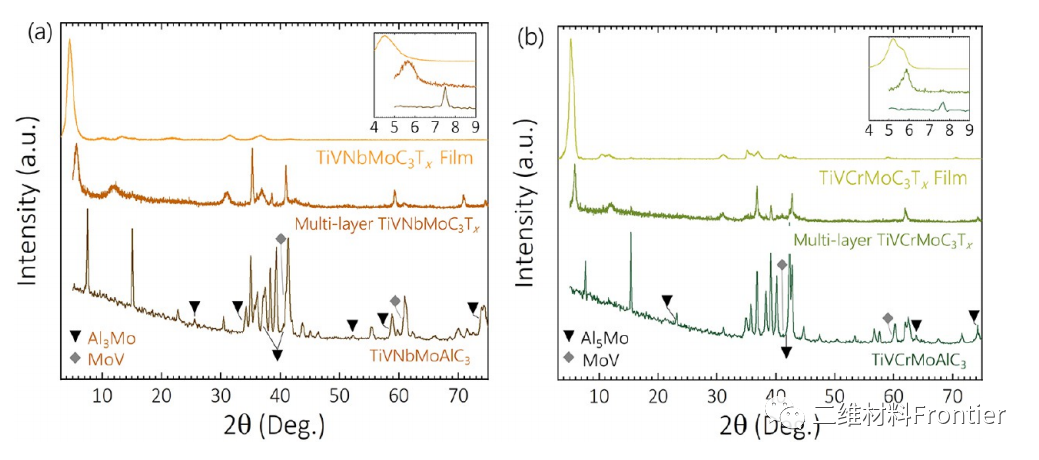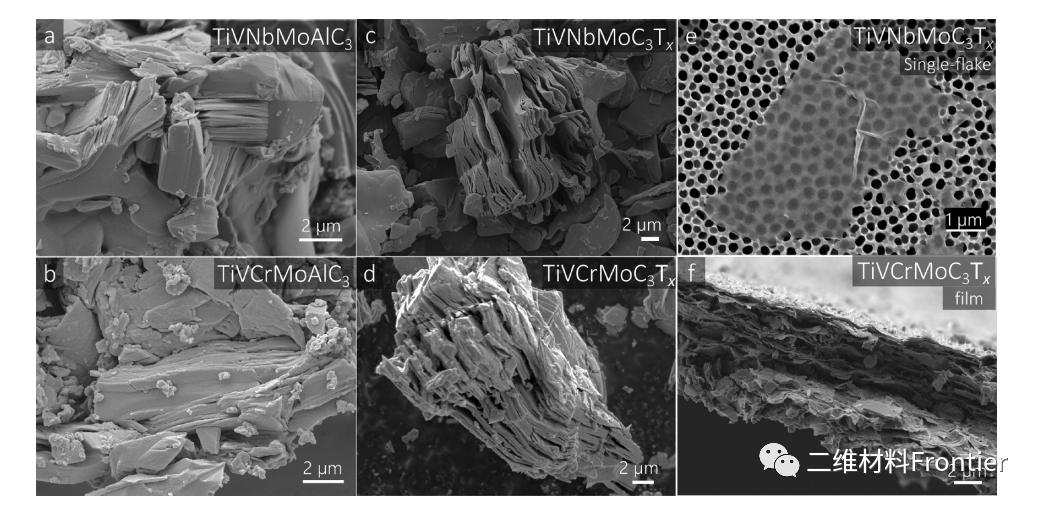
hotline£º
17715390137
Tel/Wechat£º
18101240246 (Technology)
0512-68565571
Email£ºmxenes@163.com £¨Sales Engineer£©bkxc.bonnie@gmail.com
Scan the code to follow or search the official account on WeChat:
2D Materials Fronrier After paying attention,
click on the lower right corner to contact us,
Enter enterprise WeChat.
Professional Services Online

I. Overview of the article.
Mxene is a rapidly developing two-dimensional material family, but so far its composition is limited to one or two transition metals. In this paper, we have studied and realized the synthesis of four kinds of transition metal multi-main elements high entropy M4C3Tx. Two kinds of high entropy MXenes,TiVNbMoC3Tx and TiVCrMoC3Tx, and their precursors TiVNbMoAlC3 and TiVCrMoAlC3 high entropy MAX phases are introduced in this paper. In this paper, the structure, phase purity and molar distribution of four transition metal phases in high entropy MAX and MXene were established by combining real space and inversion space characterization (x-ray diffraction, x-ray photoelectron spectroscopy, energy dispersive x-ray spectroscopy and scanning transmission electron microscope). In this paper, the formation energy is calculated by using the first principle, and the synthesis of these high entropy maximum phases is explored.
Second, guided reading of picture and text.

Figure 1. Schematic diagram of high entropy MAX and Mxene synthesis.
Reactive active sintering of (a) high entropy maximum X phase. The element powder mixture with stoichiometric molar ratio was sintered in an alumina crucible in a tube furnace. (b) M1M2M3M4AlC3s MAX phase cell (left) with elements Ti (pink), V (orange), Nb or chrome (blue), Mo (green), Al (red), and C (black). The MAX phase of the synthesized layered transition metal layer consists of four transition metal elements, aluminum (red) and carbon (MAX structure M4AlC3) atomic layer (right). (c) uses hydrofluoric acid to selectively etch aluminum layer to synthesize multi-layer high entropy xenon gas. The end of the surface on the MXenes (Tx) base plane is shown in yellow. (d) completes the delamination of multi-layer MXen by organic molecular intercalation to form a single sheet of high entropy MXeneTiVNbMoC3Tx and TiVCrMoC3Tx.

Figure 2. XRD mode of high entropy MAX phase and Mxene phase.
XRD diagram of (a) TiVNbMoAlC3 MAX and TiVNbMoC3Tx Mxene. XRD diagram of (b) TiVCrMoAlC3 MAX and TiVCrMoC3Tx Mxene.These diagrams show the change of the diffraction peak from the precursor of the MAX phase to the exfoliated multi-layer MXenes, and then delamination to single to few MXene films, indicating the peak change of (002) during the evolution from MAX to monolayer MXene.

Figure 3. SEM micrographs of high entropy MAX phase and Mxene phase.
(a) TiVNbMoAlC3 and (b) TiVCrMoAlC3 show the lamellar formation of typical MAX phase structure. (C, d) etching multi-layer MXene powder of (c) TiVNbMoC3Tx and (d) TiVCrMoC3Tx, and selectively etching aluminum layer of MAX phase to form an accordion-like shape. TiVNbMoC3Tx MXene monolithic on (e) alumina substrate. (f) TiVCrMoC3Tx MXene vacuum assisted filtration membrane.

Figure 4. EDS results for XPS and STEM.
(a-f) XPS spectra of TiVNbMoC3Tx and TiVCrMoC3Tx. (the atomic percentage of the h) MXenes XPS and the Ar+ etching time. High-angle annular dark field (HAADF) STEM image of (i) TiVNbMoC3Tx MXene. The combination of (j) HAADF STEM and the EDS results of TiVNbMoC3Tx (top) and TiVCrMoC3Tx (bottom) shows that the different layered morphology and atomic distribution of Ti, V, Nb/Cr, Co and C atoms are consistent.
III. Summary of the full text.
In this paper, two high entropy MAX phases, TiVNbMoAlC3 and TiVCrMoAlC3, were successfully synthesized by traditional pressureless reaction sintering, and two kinds of high entropy MXenes phases from monolayer to few layers were synthesized by selective etching based on hydrofluoric acid and delamination of tetramethylammonium hydroxide: TiVNbMoC3Tx and TiVCrMoC3Tx.The successful synthesis and purity of high entropy MAX phase and high entropy MXenes were confirmed by XRD, SEM and STEM, and the equal molar ratio distribution of transition metals in MXenes was further determined by EDS element mapping of STEM. Through first-principles calculation, the synthesizability of quaternary high entropy MAX phase is traced back to the stability driven by entropy, and the importance of high configuration entropy in the formation of pure phase and stable phase of multi-principal element MAX phase is emphasized.
This work lays the foundation for further research, and the successful integration of this strange high-entropy multi-principal element MXenes into a growing MXenes family increases the possibility. Some choices of multi-component transition metals can further promote the development of topological insulator MXene. Although the topological insulator material has not been synthesized yet, it has been predicted in theoretical research.
This information is from the Internet for academic exchange only. if there is any infringement, please contact us to delete it immediately.

| Reminder: Beijing Beike New Material Technology Co., Ltd. supplies products only for scientific research, not for humans |
| All rights reserved © 2019 beijing beike new material Technology Co., Ltd ¾©ICP±¸16054715-2ºÅ |